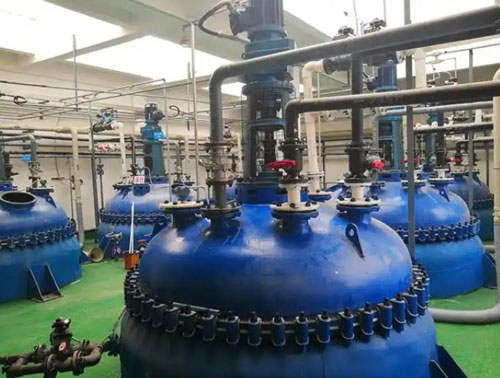Disodium phosphate is also known as disodium hydrogen phosphate (click to see what is disodium phophate )It has a wide range of applications in fields of food, watertreatment, agriculture, chemical, Pharmaceutical, and so on.
I.Food Industry
Disodium phosphate can be used as leavening agent. In the food industry, disodium hydrogen phosphate is used in baked products such as bread and cakes, to promote the fermentation of flour and improve the quality of baked goods.

In addition, disodium hydrogen phosphate can also be used as raw material for baking powder, viscosity and maturing agent for bread and sauce, powder souring agent, quality improver for light condensed milk and so on.
Principle:
During fermentation, the change of osmotic pressure inside and outside the cell will affect the growth and metabolism of the cell. Disodium hydrogen phosphate can help cells grow in a suitable environment by regulating osmotic pressure.
In some cases, disodium hydrogen phosphate can also be used as a nutrient source to provide phosphorus and sodium needed for microbial growth.

By regulating pH and osmotic pressure, disodium phosphate helps to optimize fermentation conditions and improve fermentation efficiency and product quality.
It can be used as a buffer to help maintain a stable pH in the fermentation environment. As acidic metabolites are produced during fermentation, leading to a drop in pH, disodium hydrogen phosphate can neutralize these acids, thus maintaining a suitable pH environment, which is conducive to the growth and metabolism of microorganisms.
II.Water Treatment:
Disodium hydrogen phosphate in water phosphate ions ion exchange with calcium and magnesium ions in water to produce calcium phosphate and magnesium phosphate precipitation. It is used to soften water and protect metal equipment such as pipes from being covered by scale.

III.Cleaning agent:
Used for cleaning boilers, pipelines, water pipes, and other metal equipment, etc.
It can remove oxides and rust from metal surfaces by forming stable complexes with metal ions through chelation. It can form a protective film during cleaning and polishing, which protects the metal from oxidation and rust and prevents the metal surface from rusting again.

IV.Agriculture
A. Feed additive:
Disodium Phosphate can be used as a feed phosphorus supplement additive.
B. Promotes growth:
By improving muscle mass and strength, Disodium Hydrogen Phosphate contributes to the growth of cattle, increasing fat thickness and meat production.
C. Increases milk production:
Increases phosphorus levels in cow’s body and promotes protein synthesis, thus improving milk production.

D. Enhances immunity:
Enhances the resistance of the cattle body and reduces the occurrence of disease, while stimulating appetite, promoting digestion and absorption, and improving overall health.
E. Acidity regulator
Sodium dihydrogen phosphate plays a key role in aqua feed. It is mainly used for pH regulation of fish and shrimp feeds, which can optimize the quality of feeds. It also provides the necessary nutrients to the feed to ensure the health of fish and shrimp.
V.Chemical:
Raw material for the preparation of sodium hexametaphosphate and sodium pyrophosphate.

A. Processes for the preparation of sodium hexametaphosphate from disodium hydrogen phosphate:
1.Neutralization reaction is carried out between phosphoric acid and liquid sodium hydroxide to produce disodium hydrogen phosphate.
2.The disodium phosphate is fed into a high temperature polymerization furnace and melted and polymerized at 750~850℃.
3.The molten material is quenched and pressed to obtain flaky sodium hexametaphosphate, which is crushed and sieved to obtain the product.
B. Processes of preparing sodium pyrophosphate from disodium hydrogen phosphate:
Heating dehydration method:
1. Disodium phosphate (Na2HPO4-12H2O) is heated to 115~130℃ to remove the crystalline water and become anhydrous disodium phosphate.
2. Send the anhydrous disodium phosphate to the polymerization furnace. Heat to 450℃ for melt polymerization, and then cooled and pulverized to get anhydrous sodium pyrophosphate (Na4P2O7).
3. Add anhydrous sodium pyrophosphate into the dissolving tank with water at 65 ~ 75 ℃ for dissolution, control the concentration of the solution, filtration, cooling crystallization, centrifugal separation, get the crystalline sodium pyrophosphate finished products.
VI.Pharmaceuticals
Sodium dihydrogen phosphate has a variety of uses in the pharmaceutical field.

A. Ingredient of health food products.
Provides essential nutritional and health benefits to consumers.
B. Filler
Helps improve the taste or texture of pharmaceuticals.
C. Pharmaceutical raw material
Used in the manufacture of a wide range of pharmaceuticals to meet different therapeutic needs.
All these uses reflect the importance and versatility of sodium dihydrogen phosphate in the pharmaceutical field.
In addition, disodium dihydrogen phosphate has applications in printing and dyeing industry auxiliaries, agricultural herbicides, tobacco products, and cosmetics.
VII. Conclusion
Overall, disodium hydrogen phosphate is a versatile and widely used industrial raw material, which has a very important role in many industries.

